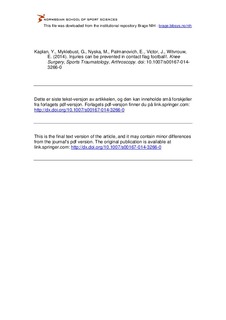| dc.contributor.author | Kaplan, Yonatan | |
| dc.contributor.author | Myklebust, Grethe | |
| dc.contributor.author | Nyska, Meir | |
| dc.contributor.author | Palmanovich, Ezequiel | |
| dc.contributor.author | Victor, J. | |
| dc.contributor.author | Witvrouw, E. | |
| dc.date.accessioned | 2015-10-27T10:47:21Z | |
| dc.date.available | 2015-10-27T10:47:21Z | |
| dc.date.issued | 2014-09-11 | |
| dc.identifier.citation | Knee Surgery, Sports Traumatology, Arthroscopy. 2014, under utgivelse. doi:10.1007/s00167-014-3266-0 | nb_NO |
| dc.identifier.uri | http://hdl.handle.net/11250/2358091 | |
| dc.description | I Brage finner du siste tekst-versjon av artikkelen, og den kan inneholde ubetydelige forskjeller fra forlagets pdf-versjon. Forlagets pdf-versjon finner du på link.springer.com: http://dx.doi.org/10.1007/s00167-014-3266-0 / In Brage you'll find the final text version of the article, and it may contain insignificant differences from the journal's pdf version. The definitive version is available at link.springer.com: http://dx.doi.org/10.1007/s00167-014-3266-0 | nb_NO |
| dc.description.abstract | Purpose: This original prospective cohort study was conducted in an attempt to significantly reduce the incidence and the severity of injuries in an intervention cohort as compared to a two-season historical cohort, and to provide recommendations to the International Federation of Football (IFAF) pertaining to prevention measures to make the game safer.
Methods: A total of 1,260 amateur male (mean age: 20.4 ± 3.9 years) and 244 female (mean age: 18.5 ± 1.7 years) players participated in the study. Four prevention measures were implemented: the no-pocket rule, self-fitting mouth guards, ankle braces (for those players with recurrent ankle sprains) and an injury treatment information brochure. All time-loss injuries sustained in game sessions were recorded by the off-the-field medical personnel and followed up by a more detailed phone injury surveillance questionnaire.
Results:
There was a 54 % reduction in the total number of injuries and a significant reduction in the incidence rate and incidence proportion between the intervention cohorts as compared to the historical cohort (p < 0.001). There was no statistically significant reduction in the number of injuries in any of the body parts, except for in hand/wrist injuries related to the use of pockets (p < 0.001), as well as the severity of mild-moderate injuries (p < 0.05).
Conclusion:
This study provided evidence that hand/wrist injuries can be significantly reduced in flag football. Recommendations to the IFAF include strict enforcement of the no-pocket rule, the use of soft headgear, comfortable-fitting ankle braces and mouth guards and additionally, to change game rules concerning blocking. | nb_NO |
| dc.language.iso | eng | nb_NO |
| dc.publisher | Springer Verlag | nb_NO |
| dc.subject | contact flag football | nb_NO |
| dc.subject | sports injuries | nb_NO |
| dc.subject | prevention | nb_NO |
| dc.subject | intervention | nb_NO |
| dc.title | Injuries can be prevented in contact flag football! | nb_NO |
| dc.type | Journal article | nb_NO |
| dc.type | Peer reviewed | nb_NO |
| dc.subject.nsi | VDP::Medical disciplines: 700 | nb_NO |
| dc.source.journal | Knee Surgery, Sports Traumatology, Arthroscopy | nb_NO |
| dc.description.localcode | Seksjon for idrettsmedisinske fag / Department of Sports Medicine | nb_NO |
